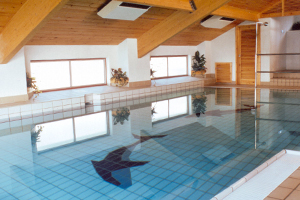


 In this article we will look at the problems caused by high levels of humidity in indoor pools and how climate control can be used to regulate the problem.
In this article we will look at the problems caused by high levels of humidity in indoor pools and how climate control can be used to regulate the problem.
Condensation and humidity.
The air in most poolrooms can easily become very humid, that is, warm and relatively moist.
When that humid air comes into contact with a cold enough surface, you get condensation. The relative ‘coldness’ of that surface is called the dew point.
The dew point is the temperature at which water vapour condenses out of the humid air and turns back into water, and that temperature will depend on how warm and how ‘wet’ the air is, among other things.
Where you have condensation occurring you can get all sorts of problems; mould might start to grow, corrosion might occur and when you include chlorine from the pool chemicals you get air that is highly corrosive and will attack both metal and concrete.
And people will feel that the poolroom is muggy and uncomfortable.
Fortunately there are things that you can do about it.
Climate control functions.
In an ideal world you want the maximum humidity of the air in your poolroom to be between 55% and 65%.
In order to do that, climate control equipment can provide different types of functions that include:
- Air heating or cooling.
- Dehumidification.
- Air circulation.
- Ventilation and heat recovery of that ventilated air.
What all these functions are trying to achieve is to make the poolroom comfortable for the people who want to use it and to protect the fabric of the building.
Heating the air in the pool room makes people feel more comfortable of course but it also means that the air can hold more moisture before it condenses out. Warmer air temperature also reduces the amount of heat lost from the pool as well as reducing the amount of water evaporating out of the pool and into the air.
If the poolroom air is kept 1°C above the water temperature while the pool is uncovered and in use it will make a significant difference.
Controlling condensation.
As we have said, condensation will form on surfaces that are colder than the rooms air dew point temperature, so you can control the problem by making the air less humid or those surfaces less cold.
In your poolroom those cold surfaces are likely to be windows and window frames, doors and the roof space if it is insufficiently insulated.
Good double glazing is obviously going to help, a vapour barrier between a false ceiling and the roof space will help as will good roof space ventilation, ducted heating around windows and doors will keep them warmer and reduce condensation there.
The other way to approach the problem is by making the air less humid.
When your pool isn’t in use, then a pool cover should be in place and that will prevent evaporation as well as heat loss.
But you aren’t going to have that cover on all the time so some form of dehumidification may well be necessary.
Controlling poolroom humidity.
If you are in a hot and humid room the simplest thing to do is just open the windows and let the fresh air in.
The problem with that solution is that you are also letting the heat out and that is warmth that you have paid for and still want. A fresh air system with heat recovery can solve that dilemma.
Rather than simply exchanging the air in your poolroom, a heat recovery system will pass the air through a heat exchanger so that about 70% of the heat in the outgoing, humid air is transferred back into the incoming air and therefore not lost.
The other option is a heat pump dehumidifier.
These devices sit in your poolroom and suck air in and extract the water vapour from it. They might also be fitted with an air heater so if you place them near windows or cold spots, they will be doing two important jobs at once.
Some of this technology has to be designed in and some can be retrofitted.
As you can see, there are many different ways to control the conditions in your poolroom. If you would like some specific advice then we can help you find a pool professional with the appropriate skills and experience right for you.
There is a link at the top of this article that can get that process underway.
We hope this article has been of use to you. There are many more articles on this site that will give you information on almost every aspect of your pool.